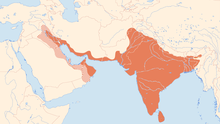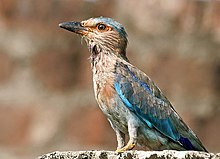Indian roller
| Indian Roller | |
|---|---|

| |
| An Indian Roller (ssp. benghalensis) from Bandhavgarh National Park, India | |
| Scientific classification | |
| Kingdom: | |
| Phylum: | |
| Class: | |
| Order: | |
| Family: | |
| Genus: | |
| Species: | C. benghalensis
|
| Binomial name | |
| Coracias benghalensis (Linnaeus, 1758)
| |

| |
| Synonyms | |
|
Corvus benghalensis | |
The Indian Roller (Coracias benghalensis), also called the Blue Jay in former times is a member of the roller family of birds. They are found in southern Asia from Iraq to Thailand and are best known for the aerobatic displays of the male during the breeding season. They are very commonly seen perched along roadside trees and wires and are commonly seen in open grassland and scrub forest habitats. It is not migratory, but undertakes some seasonal movements. Several states in India have chosen it as their symbol.
Description

The Indian Roller is a stocky bird about 26–27 cm long and can only be confused within its range with the migratory European Roller. The breast is brownish and not blue as in the European Roller. The crown and vent are blue. The primaries are deep purplish blue with a band of pale blue. The tail is sky blue with a terminal band of Prussian blue and the central feathers are dull green. The neck and throat are purplish lilac with white shaft streaks. The bare patch around the eye is ochre in colour. The three forward toes are united at the base.[2] Rollers have a long and compressed bill with a curved upper edge and a hooked tip. The nostril is long and exposed and there are long rictal bristles at base of the bill.[3][4]
Three subspecies are usually recognized. The nominate form is found from West Asia (Iraq, Arabia) to Bangladesh and north of the Vindhyas ranges. The subspecies indicus is found in peninsular India and Sri Lanka. The southern form has a darker reddish collar on the hind neck which is missing in the nominate form. The race affinis of northeastern India and Southeast Asia (Thailand, Yunnan, Indochina) is sometimes considered a full species, but within the Indian region, it is seen to intergrade with benghalensis. The form affinis is darker, larger and has a purplish brown and unstreaked face and breast.[2] It has the underwing coverts a deeper shade of blue.[3][5]
Habitat and distribution

The main habitat is cultivation, thin forest and grassland. They are often seen perched on roadside electric wires.[2]
This roller is found mainly on the South Asian mainland but extends into Sri Lanka, the Lakshadweep and Maldive Islands and into Southeast Asia and parts of West Asia.[5]
Behaviour and ecology
These birds are usually seen perched on prominent bare trees or wires. They descend to the ground to capture their prey which may include insects, arachnids,[6] small reptiles (including Calotes versicolor[7] and small snakes[8]) and amphibians. Fires attract them[2] and they will also follow tractors for disturbed invertebrates. In agricultural habitats in southern India, they have been found at densities of about 50 birds per km2. They perch mainly on 3—10 metre perches and feed mostly on ground insects. Nearly 50% of their prey are beetles and 25% made up by Grasshoppers and crickets.[9][10][11] The feeding behaviour of this roller and habitat usage are very similar to that of the Black Drongo.[12] During summer, they may also feed late in the evening and make use of artificial lights and feed on insects attracted to them.[13] They are attracted to swarms of winged termites and as many as 40 birds have been seen to perch on a 70 metre stretch of electric wires.[14] Their habit of feeding near roadsides sometimes results in collisions with traffic.[15][16] A decline in the numbers of these birds seen along roadsides in northern India has been noted.[17]

The display of this bird is an aerobatic display, with the twists and turns that give this species its English name. The breeding season is March to June, slightly earlier in southern India. Displays when perched include bill-up displays, bowing, allopreening, wing drooping and tail fanning.[2] Holes created by woodpeckers or wood boring insects in palms are favoured for nesting in some areas.[10] Nest cavities may also be made by tearing open rotten tree trunks or in cavities in building.[3] The cavity is usually unlined and is made up mainly of debris from the wood. The normal clutch consists of about 3-5 eggs. The eggs are white and broad oval or nearly spherical.[4] Both sexes incubate the eggs for about 17 to 19 days.[5] The young fledge and leave the nest after about a month. Nearly 80% of the eggs hatch and fledge.[18]

The call of Indian Roller is a harsh crow-like chack sound. It also makes a variety of other sounds, including metallic boink calls. It is especially vociferous during the breeding season.
The bird bathes in open water by plunge-diving into it, a behaviour often interpreted as fishing[19][20] [21] but may occasionally attempt fishing from water.[5]
Blood parasites Leucocytozoon of the family Plasmodiidae have been noted in the lung tissues[22] as also parasitic helminth worms Hadjelia truncata and Synhimantus spiralis.[23][24]
In culture
Being very common in the populated plains of India it is associated with legends. A local name is neelakant (meaning "blue throat"),[25] a name associated with the deity Shiva (who drank poison resulting in the blue throat). During former times, a captive roller would be released by the local ruler during festivals such as Dussera.[26] The Indian roller has been chosen as the state bird by the Indian states of Bihar, Karnataka, Orissa and Andhra Pradesh.
References
- ^ Template:IUCN2008
- ^ a b c d e Rasmussen PC & JC Anderton (2005). Birds of South Asia: The Ripley Guide. Vol. 2. Smithsonian Institution & Lynx Edicions. p. 270.
- ^ a b c Baker, ECS (1927). Fauna of British India. Birds. Volume 4 (2 ed.). Taylor & Francis, London. pp. 224–227.
- ^ a b Whistler, Hugh (1949). Popular handbook of Indian birds (4 ed.). Gurney and Jackson, London. pp. 293–295.
- ^ a b c d Ali, S & S D Ripley (1983). Handbook of the birds of India and Pakistan. Vol. 4 (2 ed.). Oxford University Press. pp. 116–120.
- ^ Sharga,US (1936). "Indian Roller or Blue Jay (Coracias benghalensis Linn.) feeding on a scorpion". J. Bombay Nat. Hist. Soc. 39 (1): 179.
- ^ Evans,GH (1921). "The food of the Burmese Roller (C. affinis) and of the Ashy Drongo (D. nigrescens)". J. Bombay Nat. Hist. Soc. 27 (4): 955–956.
- ^ Biddulph,CH (1937). "The Southern Indian Roller or Blue Jay Coracias benghalensis indica (Linn.) killing a small snake". J. Bombay Nat. Hist. Soc. 39 (4): 865.
- ^ Sivakumaran, N & K. Thiyagesan (2003). "Population, diurnal activity patterns and feeding ecology of the Indian Roller Coracias benghalensis (Linnaeus, 1758)" (PDF). Zoos' Print Journal. 18 (5): 1091–1095.
- ^ a b Mathew,DN; Narendran,TC; Zacharias,VJ (1978). "A comparative study of the feeding habits of certain species of Indian birds affecting agriculture". J. Bombay Nat. Hist. Soc. 75 (4): 1178–1197.
{{cite journal}}: CS1 maint: multiple names: authors list (link) - ^ Burton, PKJ (1984). "Anatomy and evolution of the feeding apparatus in the avian orders Coraciiformes and Piciformes". Bulletin of the British Museum. Zoology series. 47 (6): 331–443.
- ^ Asokan S & AMS Ali. "Foraging behavior of selected insectivorous birds in Cauvery Delta region of Nagapattinam District, Tamil Nadu, India" (PDF). Joural of Threatened Taxa. 2 (2): 690–694.
- ^ Bharos,AMK (1992). "Feeding by Common Nightjar Caprimulgus asiaticus and Indian Roller Coracias benghalensis in the light of mercury vapour lamps". J. Bombay Nat. Hist. Soc. 89 (1): 124.
- ^ Bharos,AMK (1990). "Unusually large congregation and behaviour of Indian Rollers Coracias benghalensis". J. Bombay Nat. Hist. Soc. 87 (2): 300.
- ^ Goenka,Debi (1986). "Lack of traffic sense amongst Indian Rollers". J. Bombay Nat. Hist. Soc. 83 (3): 665.
- ^ Sundar KSG (2004). "Mortality of herpetofauna, birds and mammals due to vehicular traffic in Etawah District, Uttar Pradesh, India". J. Bombay Nat. Hist. Soc. 101 (3): 392–398.
- ^ Saiduzzafar,H (1984). "Some observations on the apparent decrease in numbers of the Northern Roller or Blue Jay Coracias benghalensis". Newsletter for Birdwatchers. 24 (5&6): 4–5.
- ^ Asokan S; AMS Ali & R Manikannan (2009). "Preliminary Investigations on Diet and Breeding Biology of the Indian Roller Coracias benghalensis in a Portion of Cauvery Delta, Tamil Nadu, India" (PDF). World Journal of Zoology. 4 (4): 263–269.
{{cite journal}}: CS1 maint: multiple names: authors list (link) - ^ Tiwari,NK (1930). "Bathing habit of the Indian Roller (Coracias benghalensis)". J. Bombay Nat. Hist. Soc. 34 (2): 578–579.
- ^ Dalgliesh,Gordon (1911). "Roller catching its prey in the water". J. Bombay Nat. Hist. Soc. 20 (3): 853.
- ^ Radcliffe,H Delme (1910). "Roller catching its prey in the water". J. Bombay Nat. Hist. Soc. 20 (1): 225–226.
- ^ De Mello, IF & Emidio Afonso (1935). "Blood parasites of Coracias b. benghalensis with special remarks on its two types of Leucocytozoon" (PDF). Proc. Ind. Acad. Aci. (B). 2: 67–73.
- ^ Junker K & Boomker J (2007). "A check list of the helminths of guineafowls (Numididae) and a host list of these parasites" (PDF). Onderstepoort Journal of Veterinary Research. 74 (4): 315–337. PMID 18453241.
- ^ Bhatia, BL (1938). Fauna of British India. Protozoa. Volume 1. Taylor and Francis, London. pp. 240–241.
- ^ Anonymous (1998). "Vernacular Names of the Birds of the Indian Subcontinent" (PDF). Buceros. 3 (1): 53–109.
- ^ Blanford, WT (1889). Fauna of British India. Birds Volume 3. Taylor & Francis, London. p. 105.
Other sources
- Stonor,CR (1944) A note on the breeding habits of the Indian Roller, Coracias benghalensis (Linnaeus). Ibis 86(1), 94-97.
- Biswas,B (1961). "Proposal to designate a neotype for Corvus benghalensis Linnaeus, 1758 (Aves), under the plenary powers Z.N. (S) 1465". Bull. Zool. Nomen. 18 (3): 217–219. Also Opinion 663
- Lamba,BS (1963) The nidification of some common Indian birds. 5. The Indian Roller or Blue Jay (Coracias benghalensis Linn.). Res. Bull. Panjab Univ. 14(1-2):21-28.
External links
- Indian Roller videos, photos & sounds on the Internet Bird Collection
Habits, behavior, plumage





